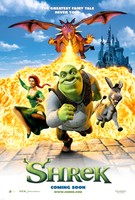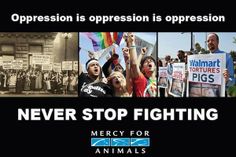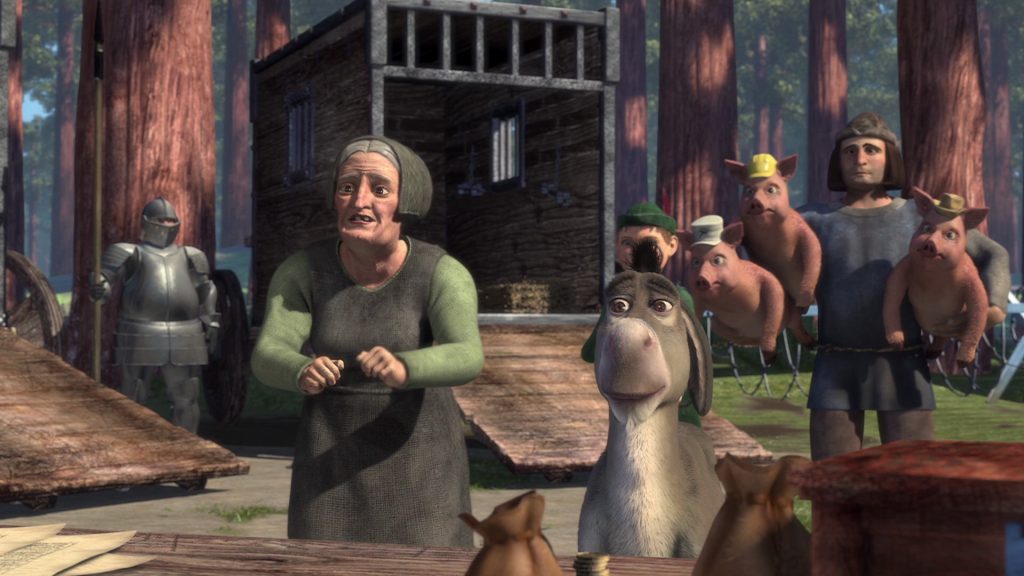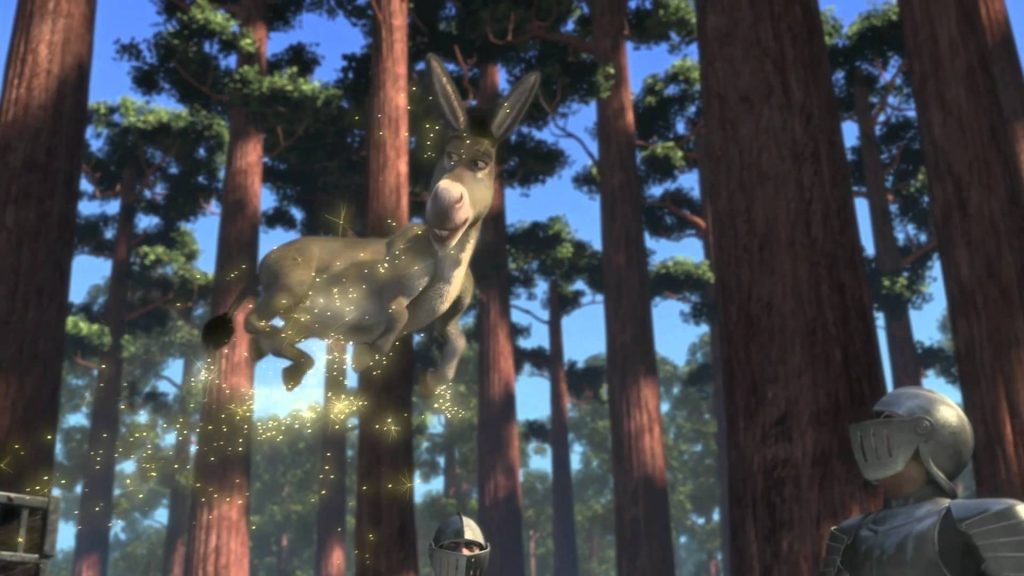
Directed by Vicky Jenson and Andrew Adamson
Produced by Jeffrey Katzenberg, Aron Warner, and John H. Williams
Production Companies were Dreamworks, Dreamworks Animation, and Pacific Data Images
_____________________________________________________
While the 2001 film Shrek has a large cast of animal characters, both mythical and realistic, it is the part of Donkey that is of real interest here. There have been a great many symbolic meanings that have been attached to the animal, donkeys, throughout various ancient time periods, medieval, modern and present day with some of the allegories being referenced, adapted and manipulated within this film through the character of Donkey. However, donkeys being symbolic of the Christian faith is of most interest in exploring a short scene from 0:46 to 1:43 of a clip from the film presented below.
{Video extracted from the movie; details the entire scene with the fairy-tale creatures being sold to
Farquadd’s men. Donkey gets hits with Tinkerbell’s fairydust, giving him the temporary ability to fly.}
This is one of the earliest scenes of the film, where the audience is introduced to Donkey when his owner is attempting to sell him to Lord Farquadd’s men, rightly claiming that the animal she owns is able to talk and would be of interest to these men who are trying to capture all the magical creatures in the kingdom. The animal in question, Donkey, is going to be persecuted for his unusual ability to communicate as humans do. This brings up a point of contention for the animal-human divide largely exists because humans can communicate amongst themselves verbally, express their thoughts and protest against any injustice done to them, but this same ability is not shared with animals whose thoughts go relatively unknown. It makes humans appear unjust and disingenuous in their belief that animals are inferior due to a lack of verbal communication that can be understood by humans. When this human society within the film encounters a creature capable of talking like a human, it chooses to capture it rather than marvel at it or respectfully communicate with it. This vile behaviour is evidenced in the apparatus that surround the temporary quarters of Farquadd’s men, cages litter the surroundings waiting to be used as well as medieval looking weaponry in the far back at 1:42. These people are not interested in learning from those creatures that are different from them, these magical hybrids between animal and human, they would rather rid the kingdom of something they can’t explain. Thus, the film illustrates the injustice and falseness of those in positions of power and privilege for it exposes the extents these humans will go to oppress and marginalise any other being that differs from them.

The broken sunlight filtering into this scene, breaking through the trees at a low angle, gives the impression that this has been a full day of desperate owners bringing in their unusual, magical livestock or pets and illustrates the sheer amount of animals that have condemned and caged. The lighting also implies, for it is a sunny day with blue skies glimpsed through the tress, that this persecution is common and familiar as as audience would expect pathetic fallacy in the weather and surroundings if this discriminatory act was uncommon.
Moreover, the humour of this scene offsets the serious implications that can be garnered from analysing animals being detained for human-like qualities and magical abilities. The man, stood behind Donkey and his elderly owner, holding ‘The Three Little Pigs’ under his armpits while the pigs wear little, colourful hats, is a small humorous touch to the scene as is the elderly owner trying to be a ventriloquist when the Donkey wisely refuses to talk. The references to various Disney films, with Peter Pan voicing ‘he can fly!’ when Donkey temporarily flies over the queue of people waiting, also add humour as the reference is twisted to include a donkey flying and not a bunch of children. This is largely done because, for all intents and purposes, this is a movie designed to be appropriate for families and children. Therefore, any serious and complex symbolism ca not be made explicit and heavy-handed for it would no longer appeal to a child or parent who want comprehensible, easy viewing.

{This shot illustrates the types of medieval weaponry, cages and tools for restraint that Farquadd’s men were using
to transport and cage the magical creatures. It also shows the Three Little Pigs angrily looking on in their little
hats and under the arms of their owner. Humour is also added to the shot through Donkey’s sceptical expression.}
Another fascinating detail within the scene is the act of making Donkey able to fly, temporarily, by being hit by pixie dust that was thrown into the air as it resonates with religious symbolism. While it lasts but a few moments, the act venerates Donkey as being something capable of awe and fantastical feats above and beyond the abilities of normal, non-magical humans. This newfound opportunity of freedom encourages Donkey to reveal his ability to speak when before his fear and self-preservation made him mute; therefore, during this short-lived experience of flying, Donkey became empowered by appearing to have superior capabilities than those that sought to capture him and abuse him. As Donkeys were symbols of Christianity, this could be regarded as a reference to their high status in biblical tales for Donkeys were often used as the chosen transport of Messiahs like Jesus in the New Testament. Animals in this instance, and in other cultural artworks like the Bible, become figures capable of aligning themselves with those that are superior figures within our society. However, one does wonder whether this would be of any worth to an audience that is largely children, or accompanying children who are not expecting this level of subtext. While an audience are made aware that this film is loosely set in medieval times, a period where people were overtly religious and interpreted most unusual events as being the work of God, this symbolism is designed for those viewers who watch the film with a critical eye rather than for the viewers who strictly want entertainment.

{Shot of Donkey flying over the people below and revealing his ability to talk when he thinks he can escape the situation by flying.
Blue sky and the angle of the light coming in through the trees can also be seen here.}
Donkey, however, is presented as a hybrid in this scene and many other scenes in the film; a hybrid between animal and human in combining his ability to speak with him being pulled around by his owner via a rope wrapped around just his mouth. Adding the detail of the muzzle to the short scene is intended to be comedic for it indicates how annoyed his owner has become with his constant chatter. It also makes Donkey appear distinctly vulnerable in that he is pulled around by the body part that allows him to be so extraordinary, that allows him to speak as a human does. This is important for it establishes that Donkey’s life before he meets Shrek was a lonely and restrictive life for his owner did care that he is extraordinary until she could benefit from his ability. Donkey is also a hybrid between the comedic fool and a more wise, perceptive character in that while Donkey is capable of great feats (communication) as well as wisdom (choosing when is wise to reveal he can talk), he is also a figure of comedy with his ungraceful fall back to earth when the magic wears off. Thus, animals demonstrate that they can be many more things than humans believe them capable of.